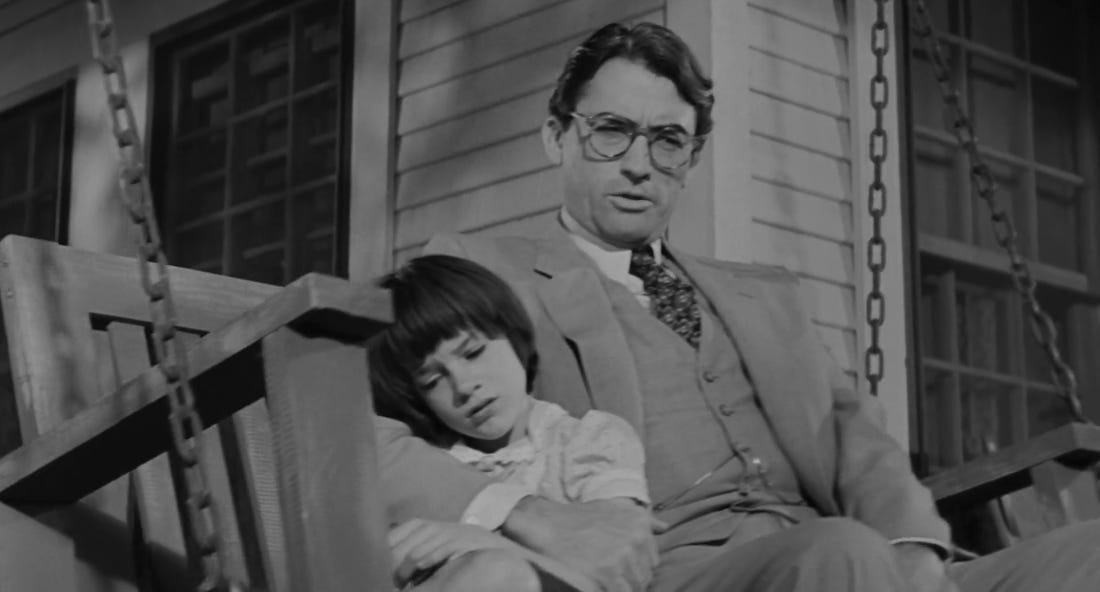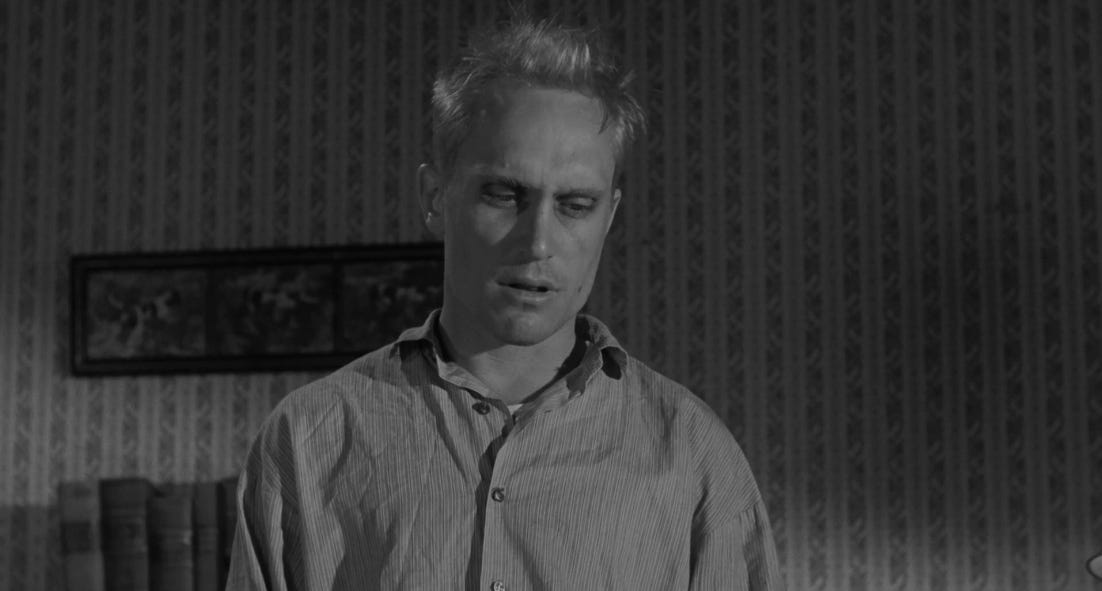To Kill a Mockingbird (1962)
Blue jays hate this one.
It doesn’t matter that it takes place in the fictional town of Maycomb, Alabama, and it doesn’t matter that it’s set during the Great Depression: To Kill a Mockingbird perfectly captures the feeling of being young on a long summer day. The film centers on six-year-old Jean Louise “Scout” Finch (Mary Badham) and her ten-year-old brother Jem (Phillip Alford) as they grow up under the platonic ideal of fatherhood, widower Atticus (Gregory Peck). We see the world through the eyes of the kids as they confront the questions of youth. Why do we have to go to school? Why are some people poor? And what’s the deal with spooky unseen neighbor Arthur “Boo” Radley (Robert Duvall)?1
Besides being World’s Greatest Dad, Atticus is also a lawyer representing Tom Robinson (Brock Peters), a Black man accused of raping and beating a white woman. At the trial, Atticus argues that the accuser actually came on to Tom, that Tom parried her advances, and that her father, Bob Ewell (James Anderson), was the one who beat her. This closing argument wins Peck an Oscar, but it doesn’t win the trial—Robinson is found guilty and is later killed by a deputy while being transported out of Maycomb.
Later, Bob Ewell, mad about Atticus’ accusations, tries to kill Jem and Scout. They’re saved by Boo, who stabs and kills Bob. It turns out ol’ Boo isn’t spooky—he’s just shy! The sheriff, knowing Ewell was tacitly responsible for Tom Robinson’s death and not wanting to drag Boo into the limelight, reports that Bob fell on his own knife.
Rating: 10/10. This movie don’t do anything but make music for us to enjoy. It don’t eat people’s gardens, it don’t nest in corncribs, it don’t do one thing but sing its heart out for us.
Cast and Crew
Harper Lee wrote the 1960 novel “To Kill a Mockingbird,” a bildungsroman2 of her upbringing in Alabama, and won a Pulitzer for it. Lee didn’t write another novel until 2015’s “Go Set a Watchman,” which was billed as a sequel to “To Kill a Mockingbird.” It was more “rough draft” than “sequel,” though, and its reviews on Goodreads range from “don’t worry, it’s okay that it’s bad” to “this retroactively ruined ‘Mockingbird’ for me.”
Before starting this project, Eldred “Gregory” Peck was one of those Hollywood Golden Age stars whose name I knew but who blended together with the Coopers, Stewarts, and Grants of the world. Maybe it was seeing him in Roman Holiday (1953), a romantic comedy role that could’ve been played by a hundred other dudes.
But Peck’s no lightweight. He studied acting under Sanford Meisner and, in the 1940s, was nominated for Best Actor four times.3 He tackled a variety of roles:
Noble hero (Elia Kazan’s Gentleman's Agreement, where Peck’s character pretends to be Jewish to write an exposé on anti-semitism)
Loving father (The Yearling, a film that’s basically live-action Bambi)
Dangerous heartthrob (Duel in the Sun, nicknamed “Lust in the Dust”)
Cary Grant when Cary Grant’s not available (Hitchcock’s Spellbound)
Stoner(Twelve O’Clock High,a film with a 2001 sequel,How High4)
1950s Peck starred in the “I’m gonna bang your wife” biblical tale of David and Bathsheba (1951) along with Westerns The Gunfighter (1950) and The Big Country (1958). He also did The Man in the Grey Flannel Suit (1956), about a WWII vet balancing his corporate job, his family responsibilities, and his raging PTSD.
We’ll see Peck next in this column as…Josef Mengele?? Wow, that’s a hard pivot from Atticus Finch.
Screenwriter Horton Foote adapted Harper Lee’s novel, but we’ll touch on him when he gets an Oscar for his original screenplay for Tender Mercies. For now, just try not to mix him up with Paddy Chayefsky, a contemporary of Foote’s who wrote the screenplay for Marty. We’ll also punt a discussion of Robert Duvall to Tender Mercies since, y’know, he actually has lines in that movie.
The Trivia
Dill (John Megna) bets Jem a Gray Ghost against two Tom Swifts that Jem won’t go past Boo Radley’s gate. What are these?
Well, the Tom Swifts are novels from Edward Stratemeyer (written under the pseudonym “Victor Appleton II”) about the titular Tom Swift.5 Swift is a young scientist who invents cool gadgets and goes on adventures. Word on the street is that the novels haven’t aged well because many of his fantastical inventions…have now been invented.
But there’s one surprising legacy to Tom Swift. Did you know that TASER is an acronym? It is—and it stands for Tom A. Swift Electric Rifle.
Edward Stratemeyer wasn’t only known for Tom Swift, though. He created numerous series of intensely readable books for juveniles, written under pseudonyms so ghostwriters could pump them out and priced so kids could buy them. Though they faced backlash for causing “intellectual torpor” in children, the Stratemeyer Syndicate created many beloved book series:
The Bobbsey Twins (debuting in 1904). Written under the pseudonym “Laura Lee Hope,” the Bobbsey Twins books follow two sets of fraternal twins: Bert & Nan (twelve years old) and Freddie & Flossie (six). They’re kids doing kid stuff, but also sometimes they go places and solve mysteries.
The Hardy Boys (debuting in 1927). These novels are about Frank and Joe Hardy, two high schoolers who solve crimes. The books were written by “Franklin W. Dixon” and even today we have Hardy Boys books.
The success of the Hardy Boys brought about Nancy Drew in 1930, written under the name “Carolyn Keene.” Drew’s also a teen detective, but while the Hardy Boys skew more action-adventure, the Drew books are straight mysteries.
There are many, many more Stratemeyer Syndicate series, ranging from the derivative (“The Dana Girls,” two teenage sisters who solve mysteries) to the bizarre (“Bomba the Jungle Boy,” a boy who was raised in the jungle). But the formula worked so well that Fortune magazine once wrote, “As oil had its Rockefeller, literature had its Stratemeyer.”6
Odds and Ends
“To Kill a Mockingbird” (the novel) starts with the line “When he was nearly thirteen my brother Jem got his arm badly broken at the elbow”…the kids all thought it was weird that Boo Radley stayed indoors all day, but that ain’t weird nowadays…the character Dill was based on Truman Capote, a childhood friend of Harper Lee; their friendship inspired some (probably misogynistic) chatter that Capote actually wrote “To Kill a Mockingbird”…Aaron Sorkin adapted “To Kill a Mockingbird” to the stage in 2018.
In the words of director Robert Mulligan, “[To Kill a Mockingbird] is about a middle-aged lawyer with two kids. There’s no romance, no violence, there’s no action.” But that’s not exactly true. Before Tom Robinson’s trial, a mob descends upon the courthouse to, presumably, lynch Tom. An unarmed Atticus is there waiting for them, and he refuses to let the mob through like he’s Gary Cooper or somethin’. And then he’s saved by his kids. Man, this is a great movie.

They believe that Boo “eats raw squirrels and all the cats he can catch,” that he “stabbed [his daddy] in the leg,” that he was “locked […] up in the basement of the courthouse,” and that his father “keeps [Boo] chained to a bed.” Spooky!
German for “novel of education.”
For The Keys of the Kingdom (1944), The Yearling (1946), Gentleman’s Agreement (1947), and Twelve O’Clock High (1949).
Twelve O’Clock High isn’t actually about that wake-n-bake, puff-puff-pass lifestyle—it’s about WWII pilots.
PSA: Tom Swift is different from Tom Sawyer.
Oh, and “The Gray Ghost”? Part of a children’s book series by Robert Schulkers. It featured mystery-solver Seckatary Hawkins, and during the Depression Seckatary Hawkins Fair and Square Clubs popped up with the slogan “a quitter never wins and a winner never quits.”





